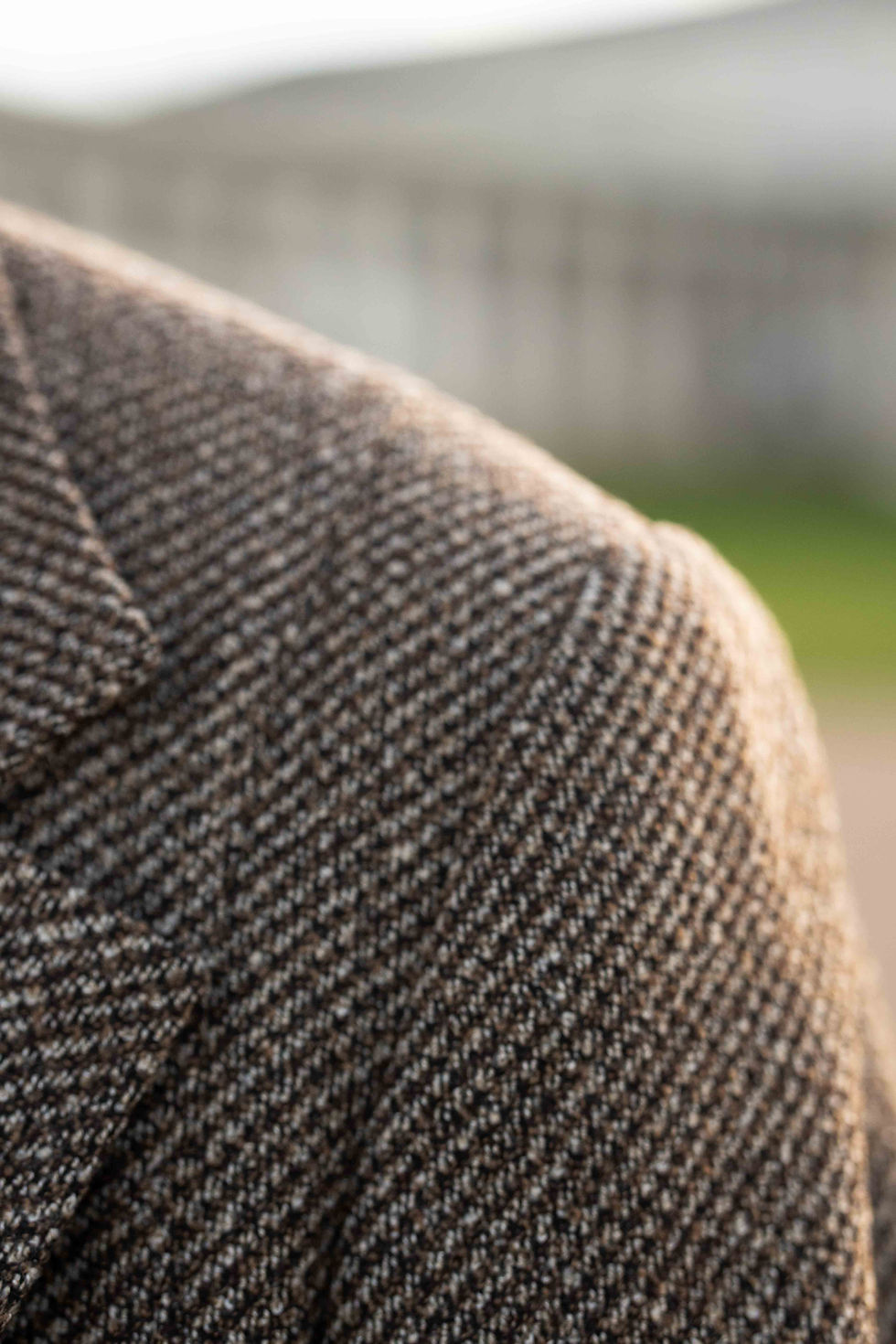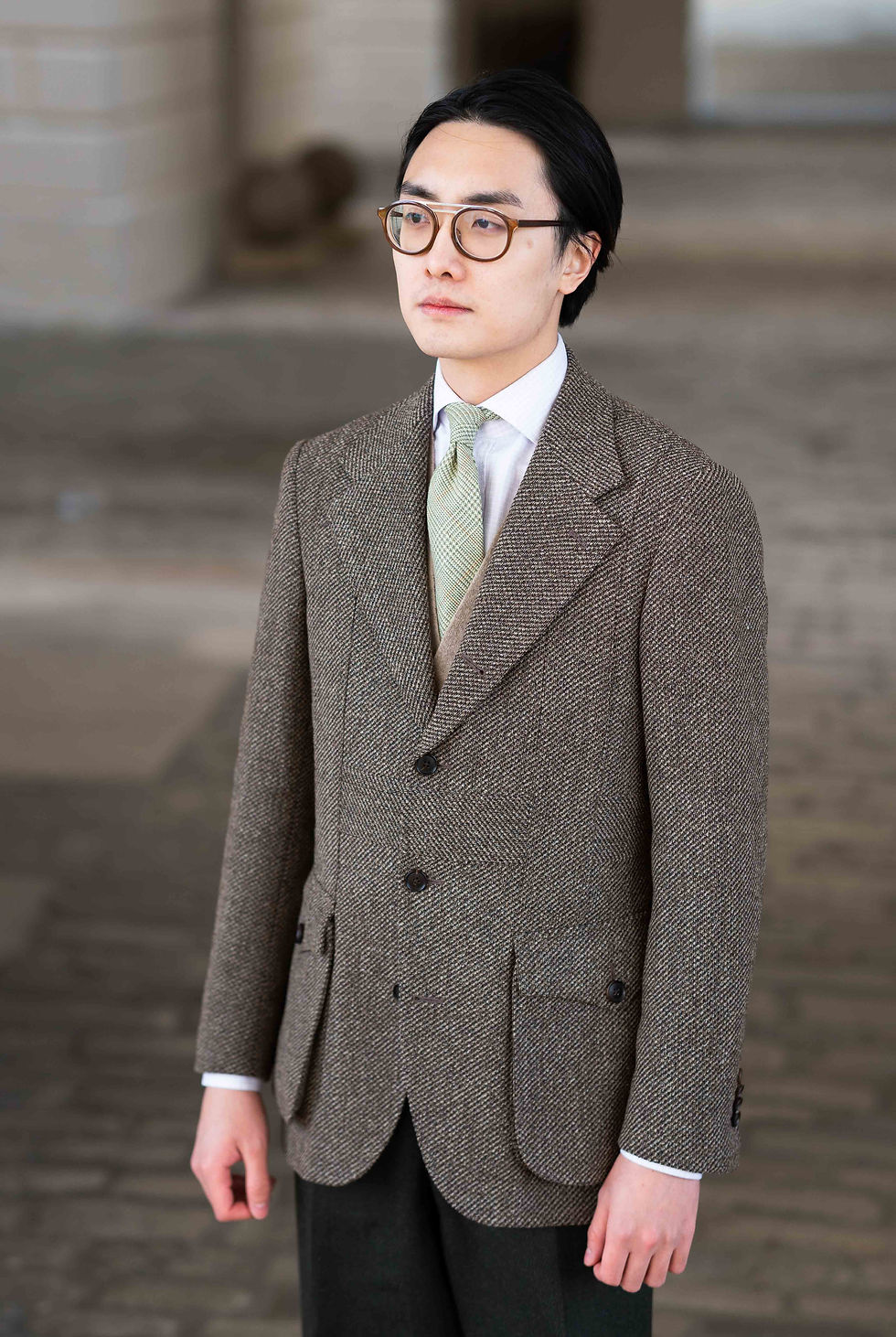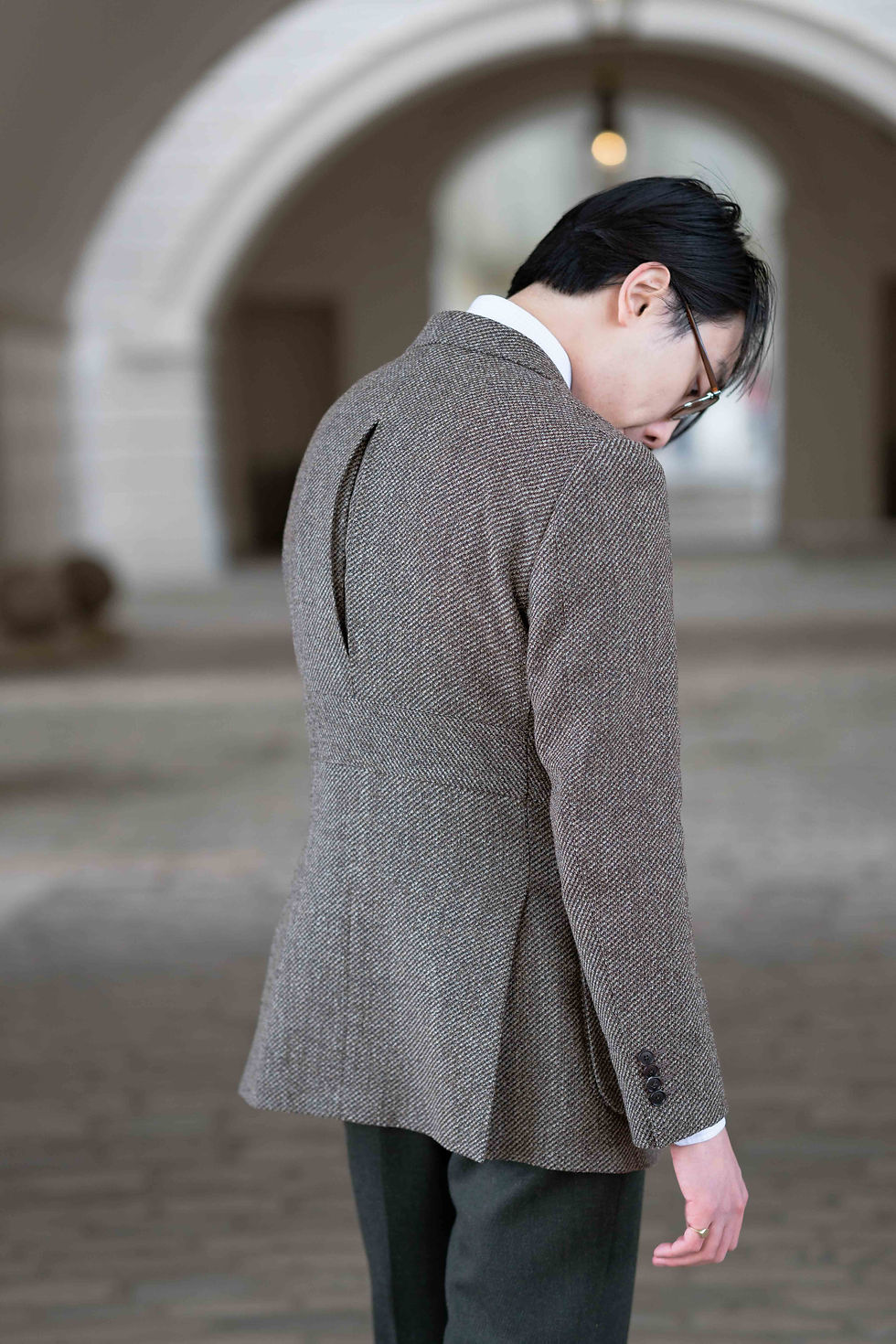Raja Fashions Semi-Custom Norfolk Jacket: Review
- Linus Chu

- Mar 20, 2023
- 8 min read

Being a menswear writer of Hong Kongese origin, I am often asked about my view on the various tailors that are based out there. One of which is Raja Fashions, a bespoke atelier that boasts itself with more than 60 years of history.
Now, readers who are even slightly familiar with the tailoring scene in Hong Kong may be instantly skeptical about the quality of make from Raja, considering the latter's position and roots as a Tsim Shai Tsui ('TST') tailor.
For the uninitiated, TST tailors have long received bad reps for being inferior to Central-based tailors, say, WW Chan and The Anthology (whom I reviewed back in 2019), given their connotations with the budget (fused) 'bespoke' suits offerings Hong Kong was known for throughout the second half of the past century.
Needless to say, let stereotypes be stereotypes. It is rather pointless to perpetuate this viewpoint without acknowledging, or at least examining what actions the newer generation proprietors of these tailors are taking to modernize their house's image and, more importantly, their quality.
So when Prashant Daswani, the current owner of the business, invited me for a showroom visit during my stay in Hong Kong last winter, we came up with the idea of making me a piece that one normally would hardly expect from a TST tailor, for the purpose of illustrating the range Raja can offer.

There was plenty to browse from inside the showroom, given the multiple sub-brands Prashant is running under the wider Raja Fashions banner. From an interior design angle, it didn't give off the impression that it is a premise of a typical 'quick and affordable' TST tailor. Rather, it felt more like the tailoring section of a department store.
Ultimately, what caught my attention was a Norfolk jacket, which to my knowledge, was made for a previous exhibition or trunk show Raja did in the States. I have always wanted one for myself but there has never been enough imperative for me to actually purchase one.
If anything is to be said about a Norfolk jacket, it would be the fact that it has a unicorn level of existence even in the UK sartorial community, not to mention the fairly reserved scene in Hong Kong. For a TST tailor to be able to execute a piece that has more cultural and historical flair than a go-to lounge suit truly means something special, to say the least.
There's more to it. What is particularly appealing about this Norfolk is its 'fake' full belt design, meaning the belt is actually attached to the jacket as well as the pleats.
While the design does not serve any functional purpose like waist-cinching technically speaking, it makes the piece less of an occasionwear and more contemporarily relevant, especially when paired with a muted cloth. The four-button stance does make it more unusual, however, though no less traditional, and I shall address that furthermore later.

As for the level of finishing and make, we have opted for Raja's Semi-Custom offering, rather than fully bespoke. This is due to the time constraint we had, since bespoke, of course, requires multiple fittings.
Crucially speaking, then, this write-up is by no means analyzing every finishing and fit detail of a Raja bespoke jacket to the other bespoke pieces I own exactly page-by-page, as this jacket was made by adjusting an existing, scalable block pattern, and no measurements were taken. It was also delivered without requiring any fitting.
The same should also be kept in mind regarding the construction. The Semi-Custom jacket comes in a lightweight horsehair half canvas and is normally half-lined. (It is only fully lined on this particular piece due to its back pleat and belt.) It features minimal handwork and is predominantly machine-made, which is fair given the jacket's retail price. It does, however, come with kissing buttons.
In other words, a better way to view this offering would be a cool-looking MTO jacket with customizable options on minor fit details (sleeve length, etc.) and cloth choice. This might not be something a seasoned bespoke client would be keen on, but is certainly a good, entry option for enthusiasts who have just started out and wanted to get more hands-on with the garment customization process.

Starting with the fabric, I must say this tweed is such a lovely find. The texture almost reminds me of an acorn's cupule, with its subtle hints of ivory, dijon mustard, chocolate brown, and black threads all interacting with each other harmoniously. It's relatively mid-weight as well, making it rather ideal for a three-season piece in London.
We had originally opted for an ivory linen cloth from a smaller, less well-known cloth merchant/ mill as Raja no longer carries cloth from big names, top-notch textile merchants based here in the UK or Italy. In fact, the bunches Raja has in the showroom mainly consist of worsted wools and other Super 1XXs. Prashant explained that there just isn't a big enough demand for the 'sartorially-inclined' cloth amongst his clientele.
Regardless, in an interesting turn of events, we ended up discovering a piece from Raja's substantial collection of vintage and deadstock cloth, all (peculiarly) thanks to his Semi-Custom tailor stating the back design details wouldn't work with the half-lining and thus the linen.
I think this is where Raja's heritage comes in strength, as Prashant's father, had collected tens of thousands of fabrics from a range of suppliers from China and the UK back when he was still managing the brand, and these are still available to this day. I was informed that they even have fabrics that would now be completely unthinkable, such as mink blends, in their warehouse!
The only issue is the fabrics themselves aren't traceable, as there wasn't an ordering system back then. (But then it's largely the same story for old European warehouses...) So the trick, I'd say, is to be persistent with your cloth search, and dig deep enough until you discover something you like. What's certain is that I cannot emphasize enough how helpful Prashant had been in searching for the right cloth throughout this process.



The shape of the jacket is quite good, especially as an MTO to MTM-level piece.
It certainly helps that I've opted for a size up — going for a UK Size 38 pattern block instead of the Size 36 I normally would wear. Raja's cut is rather contemporary with its shorter jacket length and it fits slim, especially at the sleeves.
For its bespoke cut (but not in this one), it also features substantial shoulder padding, comparable to that from an English military tailor, alongside a high buttoning point; thus contributing to an overall silhouette that prioritizes the emphasis on the muscularity of the chest.
Having favored fuller-bodied garments over the past few years, with soft, slightly extended shoulders and a more voluminous chest being my go-to, I personally found the lightweight (horsehair), soft-canvas construction of the Semi-Custom offering to be more compatible with my style.
The size up does translate into the fact that the jacket length is considerably longer than any other jackets I have owned — measuring 74cm from the nape (as supposed to the 72cm on my most recent Whitcomb & Shaftesbury 4*1 double-breasted jacket, for instance) — yet it is still within an acceptable length.
Plus, it helps that the trousers I wear these days are fuller as well (on top of being high-waisted), all in all allowing for a well-balanced, 50/50 ratio look commonly found amongst 40/50s era tailoring.



Elsewhere, I like the more prominent collar and the angle of lapels on this jacket, and I certainly think the lower gorge plays to the advantage of the longer jacket length. Having a lower gorge also allows for a clearer demonstration of the pleats extending all the way up to the shoulder. It would also have been too busy (for my taste) if the shoulders were reinforced with another layer of cloth, like a traditional Norfolk worn for shooting.
With regards to the sleeve pitch, there is no doubt that could have been slightly neater. (Note the diagonal creases from the back.) I tend to rest my arms more backward than most people I have come across, so it would have been better if the sleeves were set further back.
I would also have made the sleeve more voluminous from the elbow down, as the tapering is a tad too aggressive in my opinion, not to mention it makes it more restrictive when I sport the jacket with a chunky roll neck underneath.
As for the back, there is a case of collapsing on the right side, due to a low shoulder scenario. Unless it is a bespoke piece, I normally would encourage one to look beyond the situation. Post-making alteration techniques, such as adding extra padding or bringing it back to the tailor to create a deeper, slanting seam at the shoulder would only generate more issues, most notably a tighter armhole.
Taking a step back, I must say I am being nitpicky here with the fit. I don't think anyone should be expecting this level of fine-tuning to an existing pattern block, again, given this particular jacket's price point. Furthermore, Prashant has been kind to offer alterations to the jacket but I considered the issues not to be consequential enough to warrant this process.
On the positive side, the box pleat is nicely done, being cut with ample room for movement and various ways of layering underneath. The back also covers the seat well.

Let's finally address the elephant in the room — the four-button stance.
As briefly mentioned earlier, it is not out of the norm that Norfolk jackets come with a four-button stance, historically speaking. The question, however, is where they are placed.
Traditionally, the lapels on a four-button Norfolk jacket are a lot smaller, which means the top button starts a lot higher, around where one's mid-chest is located. The belt would then be placed either underneath the third button, around where the lower waist is, or be integrated as the waist-cinching buttoning point itself.
For this particular jacket, because the 'fake' belt — the extra layer of fabric — is placed precisely on the waist level, this means the second and third buttons have to be placed around them. Whereas there is usually a center button to serve as a waist-compressing, anchoring point; here, the task is distributed among these two buttons.
In other words, the waist will always be more voluminous on this jacket to ensure there is sufficient room for movement. It is quite a specific style, though it is also rather old-school Americana-looking, something I have grown to appreciate more as of late. (You bet I have worn it over the Liling Overshirt and the Arkhé Chinos...)

Overall speaking, this Norfolk jacket project has been fun to work on, not to mention the fact that I've been able to learn what Raja is capable of delivering. It will be interesting to see where Prashant is taking the brand next.
As of writing, Raja retails this jacket at around £500 in the UK but offers it at HKD$3998 if you visit their showroom in Hong Kong. This price difference is mainly due to customs duties and VAT here in the UK.
To my knowledge, Raja does trunk show in the UK, the US, Switzerland, and many other locations frequently. You can check here for their trunk show schedule.
Photography: Raja Fashions (Showroom image), The Suitstainable Man team (The rest)
Disclaimer: I was offered this jacket for free to review it. All opinions are my own.



Comments